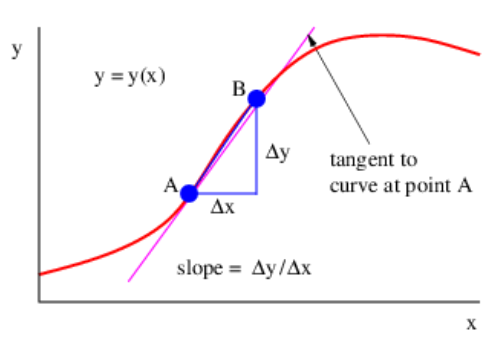1.8: Math Review — Derivatives
( \newcommand{\kernel}{\mathrm{null}\,}\)
This section provides a quick review of the idea of the derivative. Often we are interested in the slope of a line tangent to a function y(x) at some value of x. This slope is called the derivative and is denoted dy∕dx. Since a tangent line to the function can be defined at any point x, the derivative itself is a function of x:
g(x)=dy(x)dx
As Figure 1.8.15: illustrates, the slope of the tangent line at some point on the function may be approximated by the slope of a line connecting two points, A and B, set a finite distance apart on the curve:
dydx≈ΔyΔx
As B is moved closer to A, the approximation becomes better. In the limit when B moves infinitely close to A, it is exact.

Derivatives of some common functions are now given. In each case a is a constant.
dxadx=axa−1
ddxexp(ax)=aexp(ax)
ddxlog(ax)=1x
ddxsin(ax)=acos(ax)
ddxcos(ax)=−asin(ax)
daf(x)dx=adf(x)dx
ddx[f(x)+g(x)]=df(x)dx+dg(x)dx
ddxf(x)g(x)=df(x)dxg(x)+f(x)dg(x)dx (product rule)
ddxf(y)=dfdydydx( chain rule )
The product and chain rules are used to compute the derivatives of complex functions. For instance,
ddx(sin(x)cos(x))=dsin(x)dxcos(x)+sin(x)dcos(x)dx=cos2(x)−sin2(x)
and
ddxlog(sin(x))=1sin(x)dsin(x)dx=cos(x)sin(x).

